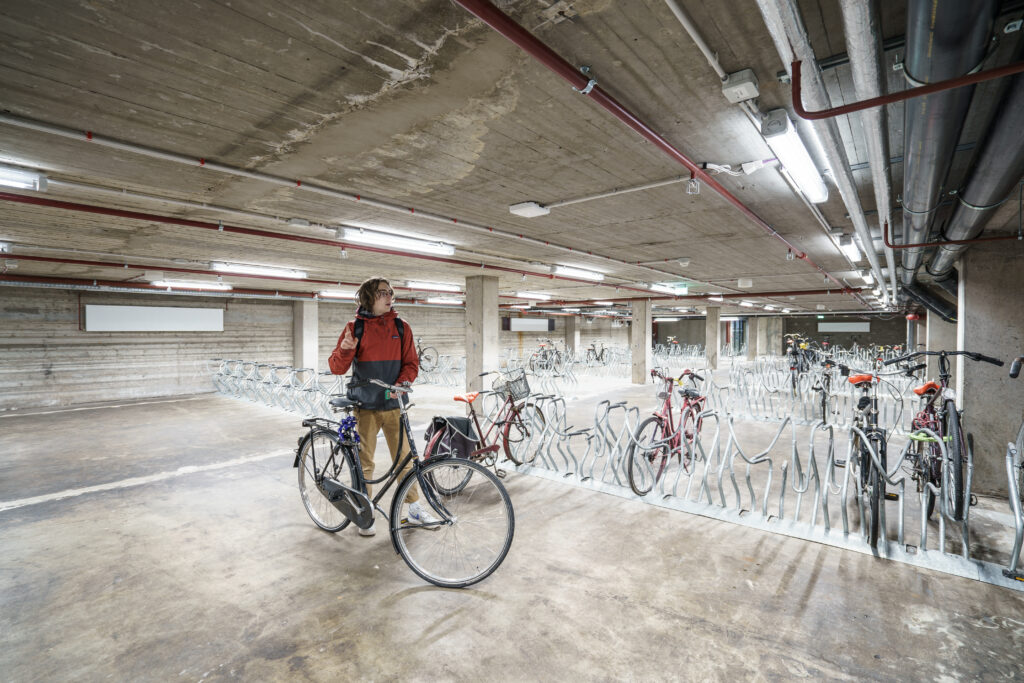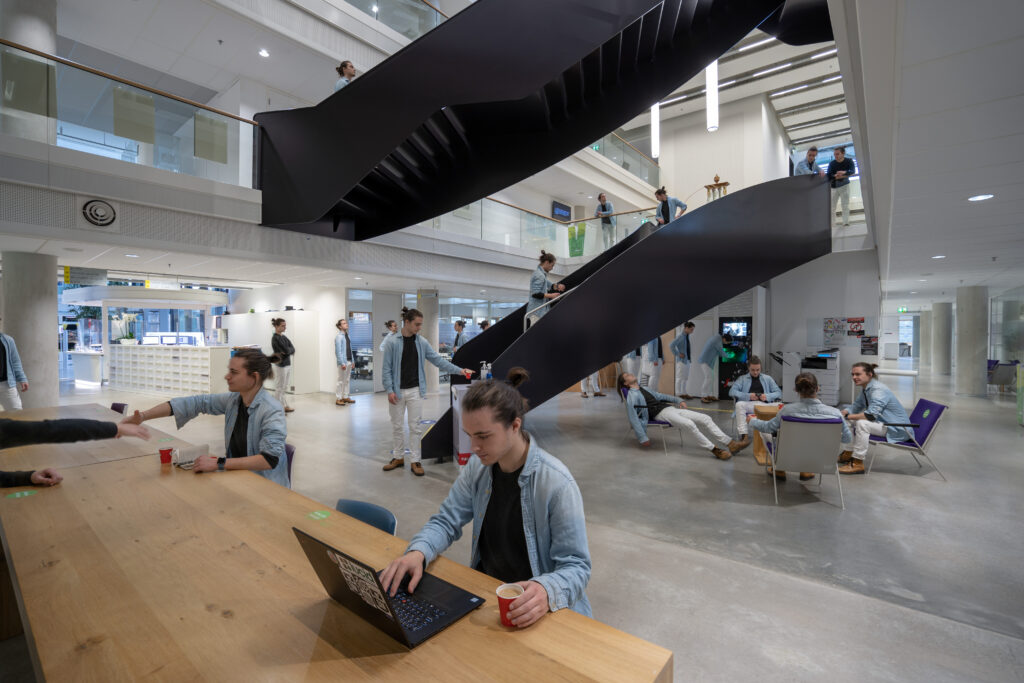Every year, Dekate Mousa creates an exhibition which in some way contributes to the cultural identity of both the association and Eindhoven. Last year we compared several typical views in Eindhoven with how they looked in the past. This year, instead of comparing our current situation with the past, we reflect on the present day while dreaming about what we want it to be. No buildings have been deconstructed in these comparisons and no new skycrapers been erected. The difference between these pictures is not time, but the pandemic that sadly has been the center point of our lifes for almost a year now.
Most students and lecturers will have this thought or said this sentence already hundreds of times in the last months: “I wanna do that, but coronatimes”. These coronatimes have changed life on campus in many different ways. We can no longer study together with our studymates, go to lectures of our course and have a drink after a long day of studying at the local bar. Student life now is not at all able to be what it used to be. Most of us spend time teaching and learning alone at home, or alone at the campus. Associations have online meetings and activities, courses and group work also now taking place online. On campus, while we are allowed on it, has been a way more silent place than it was before. This, for us, was the perfect blank slate to create our triptych’s, this year’s project.
Six different triptychs have been made, all corresponding to a different activity in different campus building. The first picture is the situation most of us find ourselves in right now. The second part shows how you could the situation, how one might want the situation to be! The last picture is reflection: does this fantasy give hope? Does it make you feel helpless? After all, the fantasy remains a fantasy, and in it you are still only accompanied by yourself!
A 5-minute ride from the campus
Biking is the hallmark of dutch society. Even during these times bikes are still all around. In some places, however, this is not the case in the Atlas bike racks. Before the pandemic finding spots for your bike is a terrible chore that has to be done every day before being able to go to the next chore: Finding a spot to sit in atlas itself. Seeing the bike racks as empty as this feels eerie, as if something is wrong. It ofcourse something is wrong, and it strangely makes me long to the time I cursed at other bikes for their terrible placement.
A logistical nightmare
Nowadays Vertigo is emptier than normal, although there are still some people working on their projects. Luckily, this means that less people use the elevators, which was a daily disaster. Usually, there was a big crowd waiting for the elevators, especially around nine o’clock. Being already late and seeing this big crowd would make many people sigh, but waiting for the elevator was still better than taking the stairs. Having to go up four flights of stairs seems a bit absurd to get only one level higher, especially when you need to be on the 4th floor. After waiting for an eternity, you could finally fit yourself into the elevator, packed like sardines in a tin can. Contrasting to most other situations on campus, the empty elevators during Corona can be a huge benefit.
The Gateway for new knowledge
Sharing knowledge in front of an audience can be a bit daunting at first. That’s why most students take their time developing their presentation skills during their studies. However, presenting has taken on a new form. Lecture halls remain empty, and the old audience is now snugly fit on a single screen. Interacting and bonding with other students has become a challenge, teachers and students will have to find new ways to work on their social skills. Hopefully we can see Audi return to its former glory over time.
The brown engery elixer
Coffee is the fluid that keeps students active to stay awake during lectures, to attend tutor sessions and work all day and all night in the library. Coffee breaks were the time to socialise and shift the mind while standing in the endless line, waiting to get that craved cup of coffee. At least it used to be. It seems that socialising this way will not be happening any time soon, but that does not mean it isn’t happening. Even though socialising isn’t what it used to be, the coffee changed for the better. Because, to be fair, the coffee at TU/e is nowhere near as good as the coffee you make at home.
A good place to work
A good workplace needs to contain the following things: Good seating, a quiet environment without any distractions, the feeling that it is a workplace. For a lot of students, their student room is a place to sleep and relax, but during Corona it also became a fulltime workplace, a place to socialise and a place to take exams which is for most students not the optimal place for all these activities. A good distinction between work and off time is necessary for productivity and sanity. However at the moment restrictions have been partly lifted, which makes it possible for students to go to the campus and study. Still, a lot of students have not come back to the campus since the pandemic started. Maybe working on campus was not always the best, with loud talking students or students who are goofing off behind their laptops. But it was also a place to socialise with fellow peers. Working on projects together, asking questions about different subjects or just talking for the fun of it. Now without other students to socialise with it is better to go to the place which has the cheapest coffee, home
Socialising on the Campus
The impact of covid-19 on Hubble Community Cafe is huge. Because of corona, we are closed for 150 days this year, 150 days where it is impossible for the members of the community to meet each other. Therefore it takes a lot of effort to keep the community alive and together. The financial consequences are big, causing troubles to support the connected associations.
Personally, with over 30 years of catering industry experience, I always get energy from the guests who have a nice event at hubble or just drink a cup of coffee/beer. The contact with the guests that I have been making possible in the background all these years have disappeared, in other words everything that I find fun and motivating in my work is not there. That is hard for me, I miss all the guests and my colleagues and hope to receive everyone again in Hubble Community Cafe as soon as possible.
Making your own sequence exposures
To edit the photos of the exhibition, 3 things are needed, namely adobe photoshop, good footage and a lot of patience! Being a perfectionist comes in handy when editing such photos. The first step is to load all the raw footage photos in adobe lightroom. Next, the filtering and some basic adjustments like exposure, color corrections, and straightening the photo are done. A selection of photos is exported and loaded into photoshop to start the actual process. Photoshop has some great tools to help you in the process of overlapping photos. It has automatic scrips to load and auto-align multiple photos into photoshop and that is exactly what is done in the editing of the exhibition photos. The photos are loaded into photoshop as separate layers so every photo can be adjusted easily. A starting default photo has to be selected that contains most of the generic information of the overall photo. After loading the selected photos/layers, a mask is added to every photo, and the actual fun can begin.
Every photo contains a little part of the complete photo that we want to create. With the help of selection tools, the right part of every photo can be cut out and placed into the final photo. The masks make sure only the part of the photo that contains an extra person is visible. The selection tools are not perfect and things like reflections and shadows have to be taken into account as well. To refine the masks, a detailed refinement with the brush tool is needed to capture all the details. After all the masks are refined, the photo full of clones is realized. The photo is exported and again loaded into photoshop to do some final white balance and color adjustments to let the three final photos match completely. And that’s it, a couple of hours later, the 3 photos of each location are exported and uploaded to the website!
Photographers: Alesander Aydin, Jorrit Bakker, Ymke Broeren, Sem Jordaan
Models: Alesander Aydin, Jorrit Bakker, Ymke Broeren, Miroslaw Faes, Sem Jordaan, Peter Joosten
Editors: Alesander Aydin, Jorrit Bakker, Richard van de Ketterij
© Dekate Mousa 2020


















